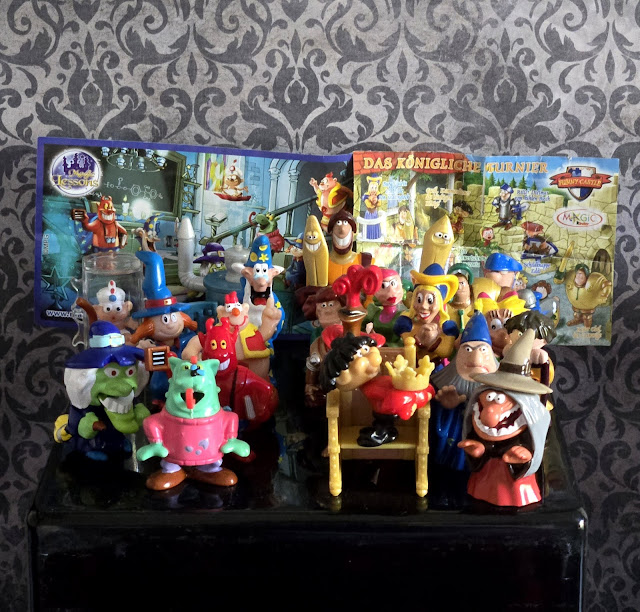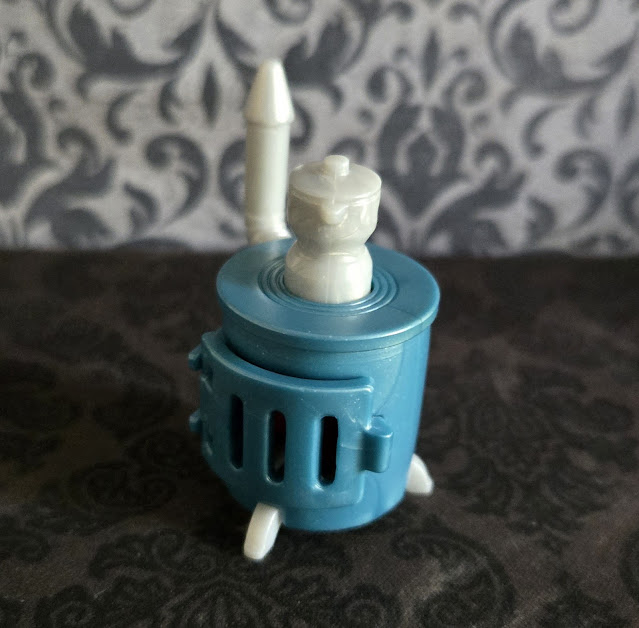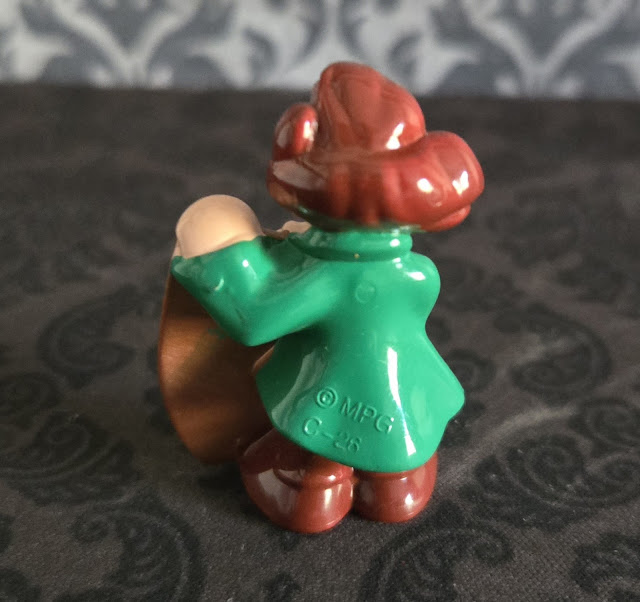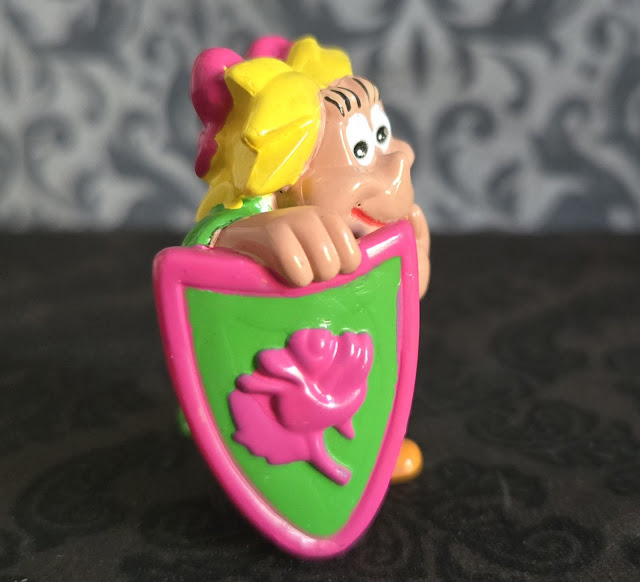(Continued from part 1 here.)
Even though I had reobtained all of my childhood Monster Hotel Kinder toys (and then some), I realized quickly when looking at the sets on eBay that one monster figure I had always lumped in with my sparse collection was absent. Clearly, I had put it in the Monster Hotel group erroneously--or at least, it wasn't ever part of the two series I had pieces from. Thus, I had to dive into the rabbit hole to figure out just where that little guy had come from. He was so distinct and I had the figure for long enough in my life that there was no chance of mismemory or fabrication--it was real just as I knew it...but whence did it originate?
Well, eventually I found it within a whole other series I had completely forgotten--thoroughly enough that the figure slid into the Monster Hotel group in my mind very early on. But where it actually came from was a set called...
Magic Lessons
This set of figures is set in a supernatural fantasy school mixing monsters and mages together with a fairly classic fantasy theme. While the concept of this set (a magic school) almost certainly owes some inspiration to Harry Potter's inescapable hold on pop culture, there's no close similarities. I was surprised, upon rediscovering this set, to find that as much as three of the set would easily slide into Monster Hotel!
My set is an Italian edition. I got the leaflet for each toy in this lot, and the names are provided for the characters, but only one bio for the whole theme is present, unchanged on each leaflet. I'm using an eBay listing selling individual characters as citation for what appears to be the characters' English names, though I know the Italian ones for certain!
This post is lower-production than the last Kinder one. I couldn't muster the interest in building scenery for these collections this time.
Here's the collector sheet for the series.
The back side has a photo of the toy in question, instructions for assembly and/or explaining an action feature, and the character name (again, the Italian ones on mine). The rest of the text is the bio for the series at large, but no individual character bios are given.
This story translates roughly to:
There's big news this year in the magic academy! Professors and pupils are looking for the Magical Clover, a plant even rarer than a four-leaf clover, because this can replace any missing ingredient to make all kinds of magic potions. Only every 10,000 years is a specimen of this Magical Clover sprouted. Prof. Potius learned one could be found right in the school... but no one, not even he, knows exactly where!
But be careful!
There are those who want to take possession of the Clover to have more power than anyone else in the magical world! But who will be searching for evil reasons?
The magical hunt has begun!
This story has no bearing on the designs or functions of the toys, but a hunt for a supremely valuable rare magical plant does sound like a fun source of drama and adventure in a magical school.
Trollo
Italian name: Krapo
This was the missing Monster Hotel cast member who never was. You can see why I put him with that group, right? I would describe this creature as a toad cat. You tell me a better description for this thing. He's a humanoid feline with warty green skin, spikes, and a long tongue. He's nothing like a mythical troll, though. The collector sheet depicts him as a student.
Pressing the spike on top of his head curls its plastic tongue out a little further to reach toward the fly on his nose!
Glad to have him back intact!
Professor Magico
(Italian name: Prof. Potius, eBay name "Master Mago", which doesn't sound right, another translation of the character in a boxed set of magic tricks said "Magico", which is nicer)
This is a professor and possibly the headmaster of the school, and may be influenced by the character of Albus Dumbledore in that respect, being a very classical Merlin-styled wizard in charge of a school. Magico is well sculpted with a pointy hat and beard that put his head in the profile of a crescent moon, and the moons and stars of his robe are well painted all around him.
He's carrying a book, and has glasses and an exuberant expression.
Magico has no special features and is just a static figure. His head is a separate piece that attaches on two pegs.
I saw evidence of another edition of this figure sculpt in an eBay lot, where the wizard had pink hair and a black or indigo robe.
The paint looks too good to be a home custom, but I couldn't find any other record of this figure palette existing, so I have no clue what its origin is.
Simsa
(Italian name: Vanitina)
This is a goofy cartoony witch girl, one of the students. She's paired with a broom, and both pieces are magnetic, though not for the purpose of connecting them together--Simsa is actually designed to repel her broom when you move her close to it, with the broom standing on its bristles and the two magnets pushing away so it looks like she is telekinetically shifting the broom across the floor. Her hand is even sculpted to reinforce the visual.
While I don't like the stylization/caricature used for her, I think this is one of the most clever Kinder play features ever.
Simsa and her broom can also attract to suggest she's riding on it.
They also make cute decor magnets.
Kiko
(Name appears to be the same in Italian and the English? list I found.)
I don't understand this figure at all, beyond the fact that he's framed as a student. He's some ball-shaped humanoid thing coming out of a pot, maybe? Or else it's a sphere? He has earrings and a vest that suggest some form of Orientalist caricature, so maybe he's supposed to be a genie of some kind, but maybe he's a clown, or...I don't know. He has a translucent red gem in his belly, and the figure is entirely hollow underneath.
There's no play functions or special features here, and the sheet doesn't say he does anything. He's just a weird little static figurine of a character design that doesn't make sense and is maybe stereotypical.
Kiko is three parts--the two halves of whatever he's attached to, and the torso. The halves of the ball are hard to pry apart and press together.
Kiko can rotate on his pot so the seams are at the sides.
This is the low point of the series for me.
Mrs. Hexalotta
(Italian name: Krapougnasse)
This is a teacher character--a classic green hag witch who would easily slide into the world of Monster Hotel.
She has a blue robe with red under her hat brim, white hair, green skin, a huge head, and a broom sculpted at her side. She has a wheel underneath and a hook mechanism inside that's supposed to move her jaw up and down as you roll her across a surface, but the wheels have no friction or grip, making it hard to engage the mechanism, and the fit of the mechanism is really janky, meaning the jaw is either too loose and wobbly, or it gets wedged and stuck..or just doesn't move too much.
I wish the engineering was tighter. Hexalotta is one pre-assembled piece, not intended to be taken apart, though she'd have been at least four or five pieces (body shells, wheel, hook, jaw) before being put together at the factory.
Mr. Teufi
(Italian name: Tok Tok)
This is another teacher--a devil who looks more like he's dressed for the beach, with shorts, no shirt, and goggles. He's holding a book and a chalkboard.
He has no special features. He's in two pieces, cut an unusual way so the head and raised arm are together.
Faki
(Italian name: Kirus)
Faki is a student, a little boy in a turban on a carpet inside a "glass" case. This can be taken as a direct Orientalist stereotype of an Indian mystic, which is a shame, especially because the figure otherwise has the coolest function in the line.
The little yellow tab piece has a magnet in it, as does the base of the figurine in the case. Sliding the tab into a slot under the case, magnet-side down, repels Faki so his carpet levitates him within the case!
This function would not work without the case to force Faki over the repelling magnet. He can come misaligned forward or backward sometimes and has to be shaken down to sit flat for the best repulsion.
I think there's some leeway given the flying carpet and folklore origins directing his design, but it still feels a little iffy subject-wise. It's a very cool play function, though.
Fridibus
(Italian name: Toor)
This is a little standing furnace with a surprise-- press the cap on top, and the door springs open to reveal a little demon!
The assembly is fairly complex. The demon sits loose on a rail inside the base, and is encircled by an elastic on hooks keeping him in place. The plunger pushes down his back and pushes him forward until the door is forced open, and the elastic pulls him back.
Including the elastic, this is eight pieces. I like the function of this toy, but it's a bit fiddly. The plunger isn't attached to the furnace, and the door can swing back in a way that dampens the action feature.
And that's Magic Lessons!
I don't know if I seriously treasure this group. Trollo is an important reacquistion, and Fridibus is a neat toy. Magico is a really good figurine. I expected to like Teufi and Hexalotta more, but Hexalotta's sculpt is a bit awkward and her feature doesn't work great, while Teufi is basic. Then there's the unappealing art style for Simsa, the questionable direction for Faki's design, and the baffling thing that is Kiko. Not all winners for me, but fun to explore.
Here's how the Monster Hotel cast would expand with additions from this set.
The Funny Castle Royal Tournament
During my rabbit hole, I found one can't-miss figure in another series, but this one was mildly more familiar.
Like Monster Hotel, this appears to be a recurrent IP in the Kinder toy range called "Funny Castle". The series appeared to debuted with this character figurine set, of which I had one figure--the king's pageboy and throne. There was also an animal-chariot set, of which I had the purple ox. It looks like, based on the colors of the carts and harnesses, these chariots were designed to match the knights in the character set, though I don't know if the figures would actually fit in the carriages. It'd be great if they did.
There was also a set of horses for the five knights (they would not be able to ride them)...
And a miniature set of the knights riding from tournament tents.
Also in the Funny Castle name, there was also a very small set of wizards and a dragon--I had the wizard with the green robe.
There was also a set of anthropomorphized forest life, and I had the tree with the striped umbrella-things on its branches.
The odd thing is that all of these plant figures, plus two palette swaps and an additional cave-creature, were also featured in another Kinder series themed on a spooky woods, which was not under the Funny Castle line.
Back to the main set at hand.
The set consists of four knights with living swords, four matching squires who carry their knights' shields, the future king's pageboy, and a wizard and witch. Guess why I wanted this set.
I only got one collector sheet here, for Squire Annabella. The figures are photographed and there's a bio for the series, but not the character. None of the figures have elaborate special features and only one has complex assembly, so I expect most of these sheets lack diagrams.
The bio translates to:
Who will be the new king of Funny Castle? The beautiful castle lady Mathilda invites the most courageous knights of the kingdom to the great tournament. The winner also wins his watch. But beware--what are the wizard Magnus and witch Grimmalda up to? Which knight will win the throne and defeat the sorcerers with the help of the clever valet Gus?
This all sounds fun, but what kind of circumstances had to occur to produce a kingdom without governance or a bloodline that could inherit? Best-case scenario, the monarch was childless and widowed and decided to abdicate, but even so, any situation where a non-ruling lady of the castle has to call a tournament for a new king sounds like a very unstable country.
Let's start with the figure I had back in the day.
Gus, Valet to the Future King
Before translating the text on the back of the leaflet, this figure was enough to help explain the concept: to wit--what's kind of astounding about this series is that there isn't a monarch included, but Gus here holding up the crown and attending the throne seems to suggest that this tournament of knights is being held expressly to determine who will become said monarch. See? No text needed to figure out the story!
The toy consists of Gus, a red-tunicked pageboy leaning back under a cushion holding a crown, and the throne waiting for a royal sitter.
Gus is four pieces--head, crown, torso, legs. Only the crown can rotate on its connection.
The crown itself fits onto the pillow but is not designed to be worn by any of the figures--not even Gus, which would be a fun plot twist. His hair sculpting almost looks like it's hiding prongs the crown can attach around, but it doesn't. The throne is four panels--the seat, the back, and the sides, and the pegs and holes are designed so it will only fit together in the correct orientation, where the spherical knobs on the side panels are the feet of the chair. I had struggled in confusion trying to build it with the knobs on the top until realizing they touch the ground. None of the figures are sculpted seated to take the throne.
Gus has the most pieces of any of the toys in this series, at eight, and I think he'd be the only one with an assembly diagram.
Village Maiden Mathilda von Maybell
Mathilda is reportedly the one who took it upon herself to end anarchy in the Funny Castle and throw a tournament to determine a king. She's a fairly classical medieval lady with a fancy hat. She has sweet freckles and looks like she's cheering on her favorite.
Mathilda is three pieces--hat, torso, and skirt. The torso and skirt are fixed in position once connected, while the hat just sits snugly on her head and has some slight room for adjustment.
Sir Friedhelm, Baron von Tartar
This is the first of the knights, and the shortest among them.
He has a serious demeanor and silver and blue armor. His visor is attached and can flip up or down. Each of the main knights has a living sword with a face, and the swords are all separate. Friedhelm can hold it behind him or in front.
The toy is two pieces--knight and sword.
Squire Willie
Each of the main knights has a squire carrying their shield with their crest. The squires all appear to be children or teens and are static one-piece figures. Friedhelm's squire is Willie, a red-haired boy with bangs covering his eyes and no dome to speak of. Realistically, the kid wouldn't have brains at all.
Friedhelm's crest is shown to be a rooster on the shield.
Willie is actually the only figure the crown piece makes sense on, since his flat head can rest it pretty easily!
Sir Olaf the Grim
Olaf is a green and gold knight with a lot of bulk. He also has a flipping visor, and his living sword has beastly teeth. It can also be held in two directions.
Olaf is three pieces--his legs are separate.
Squire Hubertus
Olaf's squire has brown styled hair and a big chin. The crest revealed on the shield shows two lions.
Sir Dietmar von Cool
This knight wears orange and maroon and looks tall and cocky. His sword also looks like a smarmy charmer.
The visor flips on this one, too. I don't think the sword can be held downward. The legs are separate.
Squire Eddie
Dietmar's squire has messy hair, freckles, and buckteeth. His shield crest is a snake.
Lady Amazonia
This character very much follows the regrettable children's media trend of being entirely "the girl one" in a male-dominated space.
She's named for the Amazon warriors, which is cool, but she's very pink and wears a chain-mail hood that lets her face and her long blonde Barbie ponytail see the daylight. Her outfit also has a slinky dress made of chain mail, which is just not practical, her armor fully defines her feminine curvature, and her living sword has kissy lips and eyelashes. It's so trite. Being the only female knight in the series is telling enough, but making it so incredibly obvious that she's the only girl is just juvenile. I think there's a space for a character like her to be deliberate camp or reclaimed femininity, but that's not what's happening here. This feels like unironic stereotyping. And Gus's title being "valet to the future king" as well as the text of the series bio speak very poorly under the idea that this tournament is being held to choose a ruler. Amazonia is expressly disqualified by that language if that's what the narrative is. She can never be a king unless she pulls a Hatshepsut and declares herself such.
Amazonia is three pieces, though it almost looks like her head would be separate. Her sword can only be held downward.
Squire Annabella
Amazonia's squire is a cute little girl with blonde hair and a hair bow. She looks kind of like a Muppet. Amazonia's crest is a rose, and not even a thorny one.
Sir Rüdiger von Buchsenberg
This knight is the most mysterious in the series, on account of not having a sword or squire, and his face being entirely covered by his narrow helmet. As such, I'm not entirely sure who he's supposed to be.
Is he a mysterious sinister "black knight" stranger interrupting the proceedings as a wild card? Is he assuming a false identity for some purpose? Is he actually a woman? ...Eh, probably not. (In this series?!?!) Personally, because he sticks out like a sore thumb, I think he best serves the role of the new king, particularly because his conspicuous red color matches nothing else except Gus's tunic, which would form a squire/knight duo between the two. Gus even matches the other squires pretty well. Rüdiger's plume and cape are also quite regal. Maybe that's the intention after all--the nobody interloper becomes the new ruler and surprises the whole kingdom. Or else he was the king who vanished and is returning to claim his territory (or just witness the effects of his absence).
Rüdiger is three pieces. The cape has pins that plug into the shoulders, and the head plugs in through the cape.
Here's the knight portion together.
Magnus the Wizard
Magnus is a Merlin type gone bad--he's one of two magical troublemakers trying to mess up the tournament. I really like his caricature and proportions, and his face is great.
The figure is hollow underneath, and the hat plugs onto his head. The connection isn't super deep or sturdy.
This is a really nice figure.
Witch Grimmalda
The second I saw this goofy, freaky witch, I needed her.
She's so caricatured with her bulbous round nose and her huge grin of sharp teeth that she honestly looks like she's part-troll! Certainly, she's a mischief-maker and probably an antagonist throwing the proceedings into chaos.
Grimmalda's face has beady bug eyes and wrinkles, and her skin is an orange tone like Ogrebear's. She's sculpted with a cascading section over the front of her head that looks like hair, but the back shows her hair to be much shorter with a flipped shape, suggesting that the front is actually a draped cloth in medieval fashion. All of it being the one color of paint is a little confusing. Her hat is dark tan with a brown buckle strap oriented sideways, and goes over a plug on her head.
This connection isn't super strong, either Otherwise, Grimmalda's squat body is wearing a brown top and an orange skirt. Her body is hollow like Magnus's.
The upper half of her face looks like a separate molded piece, but it doesn't detach.
The witch and wizard make a fun evil duo!
Grimmalda is a new favorite Kinder toy.
Here's the group all together.
It's a cute set with a fun concept. I'm really mostly about the mages and I don't like the stereotyping on Amazonia and her squire.
So these two series weren't as spectacular of an affair as getting the Monster Hotel collections I knew, but I still had fun with them and it was nice to explore.

























































































The gimmicks on the magical school ones are extremely cool, I don't think I ever got one with magnets like that! The boy in the jar is, a choice. Static figures can be some of my fav kinder guys, but he ain't it.
ReplyDeleteThe knights have a neat concept, but I'm definetly more into the steeds and carts. I'm deeply curious if the knights fit!